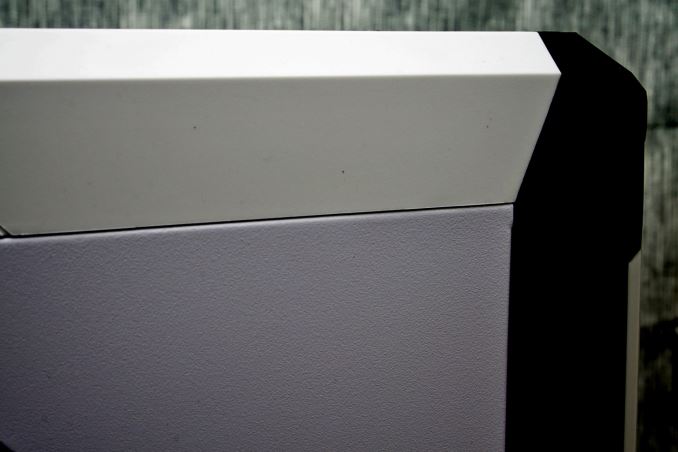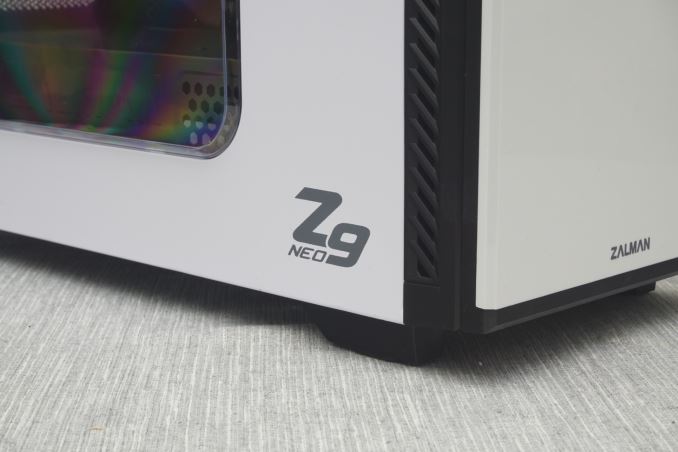The Zalman Z9 Neo Case Review
by E. Fylladitakis on May 20, 2016 9:00 AM EST- Posted in
- Cases/Cooling/PSUs
- Zalman
- ATX
- Case
Conclusion
The Zalman Z9 Neo is a product that is trying to put all of the eggs into one small basket. Its designer strived to make it solid, good looking, high performing, silent and versatile, all while maintaining a very low price tag. It is obvious that a product excelling over all of the aforementioned points with a price tag below $80 is utopian and simply cannot exist. Still, even though it is not without issues, the Zalman Z9 Neo is a positively surprising design.
One major quality issue is the use of different materials for the exterior of the case, which is causing a major visual dissonance. For example, the metallic side panels and the plastic top panel of the case are meant to be of the same color and they are most likely sprayed with the same white paint. However, the different properties of the materials change the final hue of the paint, resulting to an observable dissimilarity. We found this to be a significant issue, as the difference is easily discernible even from a distance in a well-lit room, with a significant impact on the aesthetic quality of the Z9 Neo. In terms of pure mechanical strength and solidity, the Zalman Z9 Neo is very well design and made for a case of this price range.
The use of a fixed nylon intake filter and a very thin layer of sound dampening material were also, in our opinion, poor design choices. Zalman wanted to keep the cost down and therefore implemented the simplest solutions they could find, but they are virtually ineffective. The fan filter will only block very large particles and debris, all while accessing it and cleaning it is inconvenient, and the thin sound dampening layer proved to be virtually ineffective. In our opinion, these two features could not have been implemented at all, lowering the cost of the case even further, or Zalman could implement just one of the two but in a more effective manner.
The spacious and versatile interior is perhaps the most positive feature of the Z9 Neo. There is enough room for powerful gaming systems and some top tier hardware, allowing future upgrades and easy maintenance. Its design is also helpful to modders, allowing them to easily work and modify the interior according to their needs.
It appears that the designer made a wise choice to go with five low speed fans. The stock cooling arrangement of the Zalman Z9 Neo is very efficient, providing more than enough airflow for an advanced gaming or professional system without being too noisy. The major side effect of this configuration however is that these fans have four pin Molex connectors and thus cannot be connected to a fan controller or to the motherboard, forbidding any kind of speed control from the system. It is only possible to reduce their speed by manually modifying their cabling.
In conclusion, the Zalman Z9 Neo may not be an engineering marvel, but the company did an excellent job designing a low cost versatile case with high thermal performance. With its five stock cooling fans and spacious interior, the Zalman Z9 Neo is an excellent choice for users that just want basic features but good performance right out of the box. The retail price of $73 including shipping, which gets down to just $60 for the black version, the Zalman Z9 Neo offers outstanding value for money that is very difficult to compete with.












30 Comments
View All Comments
Azethoth - Monday, May 23, 2016 - link
I still buy a big case so I can have a bunch of 200mm fans. Big and slow = quiet but good cooling. It is pretty empty in there these days though. Although 64gb of 2800 RAM sure made that empty feeling go away quickly once the lid closed.vpr - Sunday, May 29, 2016 - link
Pre-Note: I do not work for this company, just been following their progress a lot.The Kimera Industries Cerberus might be what you're looking for - http://www.kimeraindustries.com/#main-hero
They had a Kickstarter which failed, but that opened up some new opportunities. According to their forums which I've kept up with they're working out some final details before signing the paperwork and announcing the details as to what's happening next.
There's even talks of a possible ATX variant which looks incredibly small for what it offers.
The problem is part selection though more so than case selection. It's a chicken and egg problem though as power users don't support mATX because the options are lacking, yet manufactures don't put a lot of money into mATX because the power users aren't interested.
Impulses - Friday, May 20, 2016 - link
I'd argue that people jamming 4-5 drives into their case is faster than SLI at this point, yet every ATX case seems destined to have room for lots of drives...I'd love to see a slimmer ST Raven or Corsair Air 540 would, lose the drive cages but keep the straight airflow and room for enthusiast SLI/water configs.
There's still a lot of unexplored ATX form factors IMO.
erple2 - Friday, May 20, 2016 - link
I didn't realize that anyone made PCIe soundcard anymore, other than for some specialized applications, and sli/xfire hasn't really been worth the hassle IMO. Now that m.2 is pretty standard, I'm not sure what a PCIe SSD buys you anymore. I'd like a mATX case that didn't stink. My big storage is in another box attached via Ethernet, so having 5 drives in my case is too much hassle. mATX still has full features mobos (4 ram slots, at least two PCIe slots), so that's all the expandability that I need or want. And I expect that the vast majority of people agree. It pains me when people buy a giant Dell box in ATX size, using iGPU. I think I've said enough.Azethoth - Monday, May 23, 2016 - link
I grew up on sound cards in my builds. But 5 or 10 years ago I got two useless sound cards in a row. Turns out MS changed windows sound and made those guys obsolete. Then some new sound guys came out with high end cards and op amps, whatever that is etc. Lack of driver support made me finally spit on them and now I just enjoy the built in ROG sound on the MB.Azethoth - Monday, May 23, 2016 - link
Oh yeah, and who cares about sound cards when it's just a digital stream going straight to your computer's surround receiver. The new sound algorithms track individual sounds through the 3d geometry which kind of means sound belongs in the GPU anyways.Murloc - Saturday, May 21, 2016 - link
what's the point of SLI support if you're not using it?It's not something most people ever use anyway.
I've never owned a mobo bigger than mATX and I'm an average value-for-money gamer, and I didn't do it on purpose.
My case supports ATX motherboards but I don't need them when I'm aiming for the cheapest motherboard that has what I need (the chipset).
For a media PC I'd go with mITX.
PCIe SSDs are a rarity, PCIe sound cards are either for obscure use cases or for noobs, real speakers need an external amplifier anyway, and AVRs can get digital audio through HDMI and do processing themselves with Audissey and all that jazz, which a consumer sound card will never do (idk about specialized uses).
JoeyJoJo123 - Wednesday, May 25, 2016 - link
And for the average gaming PC build (which is the use-case most enthusiasts who bother to build a PC have) you see nothing more than a single GPU in the PCI-E slots, and usually less than 4 SATA drives.The usual difference between MicroATX and ATX is that one has 4 PCI-E slots and the latter has space for 5, 6, sometimes 7 slots, and ATX usually has ~2 more SATA ports, although it's still really common to find MicroATX boards these days with the standard 6 SATA ports.
You can still do Crossfire/SLI with a MicroATX.
You can still have an array of disks with MicroATX.
MiniITX's real problem is that most people don't understand the form factor and think it's a limitation rather than a freedom of case choice and additional form-factors and sizes. Additionally, for first-time builders, small MiniITX cases are incredibly difficult builds, due to stressful cable management issues, and the order you install items in the case actually REALLY matters, because otherwise, everything just won't go in right.
techxx - Sunday, May 22, 2016 - link
I think a lot of consumers are just uneducated on how legacy and obsolete ATX has been for the past few years. Like someone else said, I'd bet only 1-3% of consumers need anything more than ITX. SLI/Crossfire has never really been worth it and the needs for expansion cards is virtually non-existent.ninjaquick - Sunday, May 22, 2016 - link
I use 5 slots on my motherboard for legacy hardware, but otherwise agree that most users don't need larger than mATX. That said, it doesn't cost much more to build a low cost full atx case, and doing so widens the market a brand can reach, which is critical for the low margin low end.